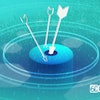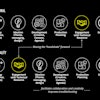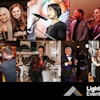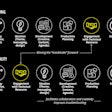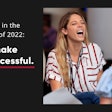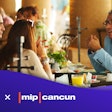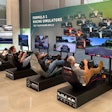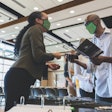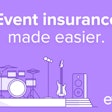The next phase of event software goes beyond making “dumb” devices like handhelds, wearables, signs, and kiosks “smart.” The newest event tech focuses on empowering attendees through interactivity and experience activation, with developers using software to deliver something more meaningful to users. Here are the latest products and services designed for meetings and conferences.
This story appeared in BizBash's Fall 2019 issue.
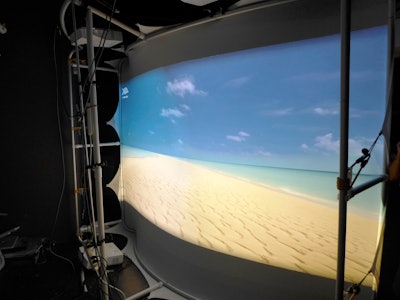
Summit Technology Laboratory recently debuted its interactive digital backdrop, a hardware-agnostic solution for projection mapping digital content onto any stationary or moving object such as shoes, clothing, walls, buildings, or a waving flag. This affordable, responsive backdrop is geared toward small- and medium-sized exhibitors. Its software blends images from multiple, off-the-shelf cameras and projectors, delivers a full range of colors, and provides sub-pixel accuracy on a curved 8- by 10-foot screen using a standard laptop. The interactive display offers numerous options for attendee engagement, including game play using a laser pointer, gesture recognition, and touch response. Plus, attendees can project their own content from a tablet or smartphone onto the backdrop by scanning a QR code.
Photo: Courtesy of Summit Technology Laboratory
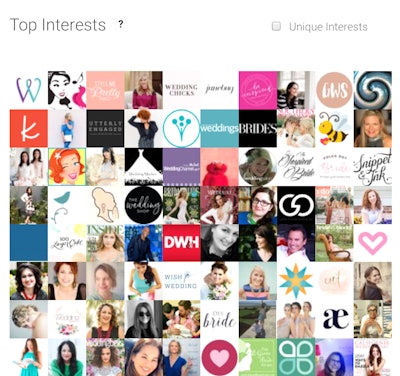
Affinio, based in Halifax, Nova Scotia, uses artificial intelligence to analyze the Twitter and Reddit feeds (it can also ingest first-party data such as registration lists) associated with a specific handle or hashtag. “It looks at all of the connections audience members share, finds the commonalities, and groups them into meaningful segments based on those interests,” explains Jackie Davies, a marketing specialist at Affinio. This allows event organizers to program and design events (even make menu selections) based on what participants care about—what they read, share, follow, re-tweet, and post. Tracking emojis, links, gifs, memes, comments, and bio keywords can help drive marketing, advertising, influencer, and sponsorship campaigns as well.
Photo: Affinio
![Chili Piper, a buyer-enablement platform provider headquartered in Brooklyn, New York, recently rolled out a solution to facilitate the scheduling, space reservation, and tracking of one-to-one and group meetings at trade shows and conferences. Plus, through a “very detailed integration, it records every meeting booked, attended, rescheduled, and canceled in Salesforce and allows [exhibitors and corporate marketers] to track a sales opportunity all the way back to the meetings and the event,” explains C.E.O. and co-founder Nicolas Vandenberghe. Attendees can book meetings through the Chili Piper dashboard, Outlook, an event’s website, or via a link included in a marketing campaign email.](https://img.bizbash.com/files/base/bizbash/bzb/image/2019/11/Chili_Piper_Events_Mobile_View_1.5ddc10fae70d0.png?auto=format%2Ccompress&q=70&w=400)
Chili Piper, a buyer-enablement platform provider headquartered in Brooklyn, New York, recently rolled out a solution to facilitate the scheduling, space reservation, and tracking of one-to-one and group meetings at trade shows and conferences. Plus, through a “very detailed integration, it records every meeting booked, attended, rescheduled, and canceled in Salesforce and allows [exhibitors and corporate marketers] to track a sales opportunity all the way back to the meetings and the event,” explains C.E.O. and co-founder Nicolas Vandenberghe. Attendees can book meetings through the Chili Piper dashboard, Outlook, an event’s website, or via a link included in a marketing campaign email.
Photo: Courtesy of Chili Piper
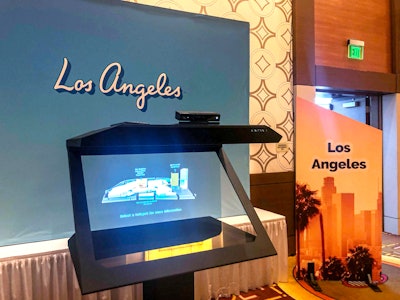
Holograms have come a long way since Tupac Shakur’s post-mortem performance at Coachella. Now, thanks to Vntana, people, products, buildings, and processes can be rendered as holograms in all sizes at events. For example, L.A. Tourism recently used the Van Nuys, California-based company’s plug-and-play kiosk display, called Z Display, to showcase the Los Angeles Convention Center’s expansion at PCMA EduCon. The software renders architectural files as holograms (the image can be updated as the building progresses), processes leads, and uses facial recognition to read the age, gender, and user sentiment. At EduCon, attendees could use hand gestures to reveal information hotspots and to make the hologram spin 360 degrees.
Photo: Courtesy of Vntana
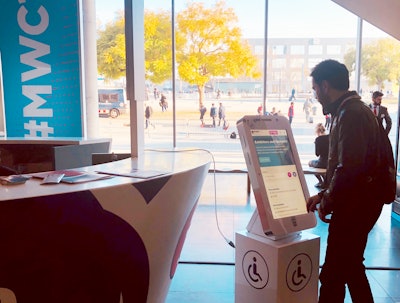
London-based Giant iTab provides touchscreen devices designed to look like large smartphones. Attendees can use them to access event content, such as exhibitor lists; floor plans; and seminar, sponsor, and speaker information. At the Mobile World Congress 2019 in Barcelona, attendees were able to download the conference’s mobile app by touching their iOS or Android mobile phones to the N.F.C.-enabled “Tap for the App” area located on each giant smartphone. The software’s interface allows users to look, tap, and swipe like those on personal smartphones and helps attendees forge relationships with brands (since content comes from the exhibitors and event organizers), and conveniently navigate an event.
Photo: Courtesy of Giant iTab
